#Sorbian mythology
Explore tagged Tumblr posts
Text
Sorbian dragon (Zmij/plon) way: You're a dragon and you don't know how to make friends? Just give them food, milk or money. There. You just made a friend. You are now allowed to move in and they are required to feed you good so you don't burn their house or leave them empty
The dragon doesn’t kidnap villagers because he’s going to eat them. He’s just got really bad social anxiety and doesn’t know any other ways of making friends.
5K notes
·
View notes
Text
[Sneakers] Phreaks Bios: Helena 'Troy' Green

Nicknamed 'Troy' after Helen of Troy, 'Troy' is an expert with blueprints and an Ex-Army Medic who was dishonourably discharged for hacking into classified files and finding out information she should not have read.
"Classified? Give me a real reason why nobody's allowed to read it."
Name
Full Legal Name: Helena Selene Green
First Name: Helena
Meaning: Latinate form of 'Helen', the English form of the Greek 'Helene', probably from Greek 'Helene' meaning 'Torch' or 'Corposant'.
Pronunciation: HEHL-e-na
Origin: Ancient Greek, Catalan, Croatian, Czech, Danish, Dutch, English, Estonian, Finnish, German, Greek Mythology, Icelandic, Norwegian, Polish, Portuguese, Slovak, Slovene, Sorbian, Swedish
Middle Name: Selene
Meaning: Means 'Moon' in Greek.
Pronunciation: si-LEE-nee
Origin: Greek Mythology
Surname: Green
Meaning: From the colour Green.
Pronunciation: GREEN
Origin: English
Titles: Miss
Nicknames: Troy, Lena
Characteristics
Age: 37
Gender: Female. She/Her Pronouns
Race: Human
Nationality: American
Ethnicity: African-American
Birth Date: 13th September 1955
Sexuality: Straight
Religion: Christian
Native Language: English
Known Languages: English, Spanish, American Sign Language
Relationship Status: Engaged
Astrological Sign: Virgo
Actor: Whoopi Goldberg

Appearance
Height: 5'5"/ 165 cm
Eye Colour: Brown
Hair Colour: Black
Hair Dye: None
Facial Hair: N/A
Tattoos: (As of Jan 1992) 8
Piercings: Ear Lobes (Both)
Scars: None
Health and Fitness
Allergies: None
Alcoholic, Smoker, Drug User: Social Drinker
Illnesses/Disorders: None Diagnosed
Medications: None
Any Specific Diet: None
Relationships
Friends: Wendy Quinn, Natasha Mussolini, Fang Tian, Spirit Norling, Jesse Haley
Significant Other: Wilson Barna (40, Fiancé)
Previous Partners: None of Note
Parents: Alexander Green (67, Father), Hera Green (63, Mother, Née Gray)
Parents-In-Law: None
Siblings: Daphne Reed (43, Sister, Née Green), Simon Green (40, Brother)
Siblings-In-Law: Phineus Reed (47, Daphne's Husband), Nieobe Green (44, Simon's Wife, Née Silver)
Nieces & Nephews: Nestor Reed (23, Nephew), Melissa Reed (37, Nestor's Wife, Née Brown), Medea Green (30, Niece), Philander Green (17, Nephew)
Children: None
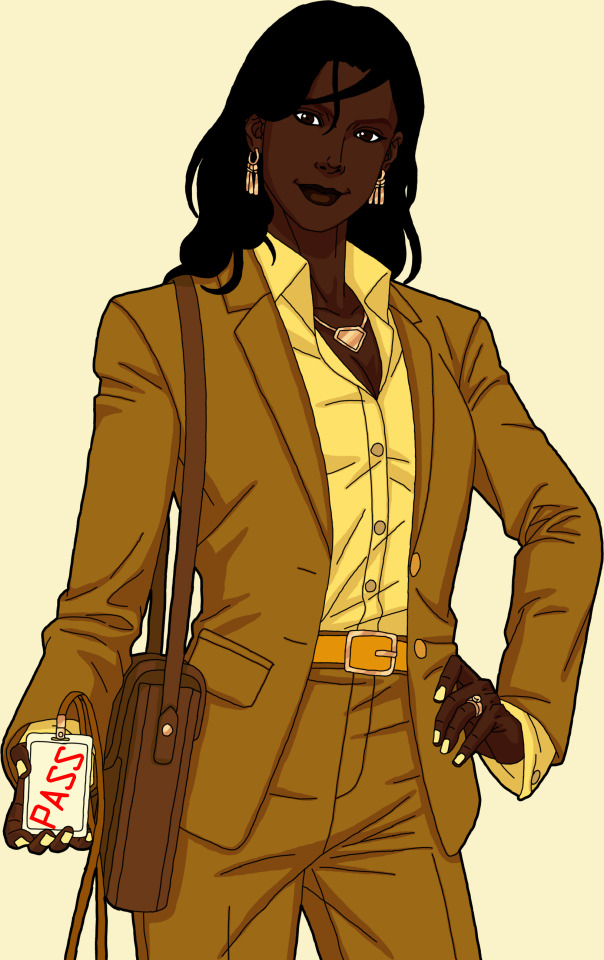
4 notes
·
View notes
Text
Poludnitsa
Poludnitsa is a character common to the various Slavic countries of Eastern Europe. She is referred to as Południca in Polish, Полудница (Poludnitsa) in Serbian, Bulgarian and Russian, Polednice in Czech, Poludnica in Slovak, Připołdnica in Upper Sorbian, and Полознича (Poloznicha) in Komi, Chirtel Ma in Yiddish. The plural form of this word is poludnitsy (or poludnici). Poludnitsa is a noon demon in Slavic mythology. She can be referred to in English as "Lady Midday", "Noonwraith" or "Noon Witch". She was usually pictured as a young woman dressed in white that roamed field bounds. She assailed folk working at noon causing heatstrokes and aches in the neck, sometimes she even caused madness.
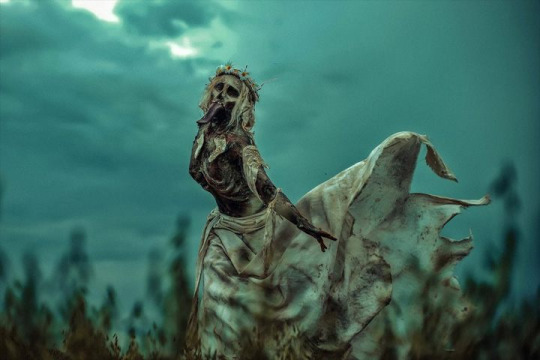
Pic by Elena Samko
In some accounts, she symbolizes the midday star, thereby being the sister of Zarya-Zarenitsa (the morning star; also called Utrenica), Vechorka (the evening star; also called Wieczornica/Vechernitsa) and Kupalnitsa (the night star; also called Nocnica/Nochnitsa); Poludnitsa is the second youngest among the sisters, with Zarya-Zarenitsa being the youngest and Kupalnitsa being the oldest.
Poludnitsa, who makes herself evident in the middle of hot summer days, takes the form of whirling dust clouds and carries a scythe, sickle or shears; most likely the shears would be of an older style, not akin to modern scissors. She will stop people in the field to ask them difficult questions or engage them in conversation. If anyone fails to answer a question or tries to change the subject, she will cut off their head or strike them with illness. She may appear as an old hag, a beautiful woman, or a 12-year-old girl, and she was useful in scaring children away from valuable crops. She is only seen on the hottest part of the day and is a personification of a sun-stroke.
According to some northern Russian regions, Poludnitsa has a giant frying pan in her hands, with which she either blocks the rye from the scorching sun's rays, or burns the rye along with the herbs during the flowering period. She may also appear at midnight and show a person how to find a flower that can make them invisible, as was believed in the Arkhangelsk Governorate.
Poludnitsa, according to beliefs, loves to dance. If she sees a girl lying down to rest in the field, she will wake her up and begin to persuade her to dance. If the girl agrees, she will be forced to dance until the evening dawn. Poludnitsa cannot be beaten in dancing; however, if such a girl is found, the noon spirit will present her with a rich dowry.
#Noon Witch#Noonwraith#Lady Midday#Poludnitsa#Chirtel Ma#Poloznicha#Připołdnica#Poludnica#Polednice#Południca#slavic europe
12 notes
·
View notes
Photo

Krabat by Otfried Preußler
Summary:
Krabat is a 1971 german fantasy novel about the eponymous Sorbian folk hero, written by Otfried Preußler.
Krabat tells the story of a 14-year-old beggar boy lured to a mysterious mill by a series of frightening dreams and apparitions.
He becomes an apprentice to the master of the watermill where he joins the eleven other young journeymen who work there. Much to his surprise Krabat soon discovers that the mill is actually a school of black magic and he is expected to learn much more than just a normal miller’s trade.
Krabat studies hard and becomes the master’s star pupil, but when he falls for a local village girl the depth of the masters evil and the darker secrets of the mill begin to reveal themselves. One by one his fellow classmates perish from mysterious, unexplained accidents and Krabat realises he must use all of the dark magic skills he has learned to secure his escape.
Status: Complete
Words: 269 pages (can’t find the word count, if you got it pls let me know!)
Rating: T
Warnings: Horror elements, Dark/ Black Magic, Murder, Use of Violence, Typical German Fairytale Violence, Character Death, Homelessness, Non consensual body modification
Category: F/M
Additional Tags: lure of evil, entrapment, manipulation, compulsion, themes of whimsy, h/c, angst, found family, brotherhood, friendship, true love, black magic, dark magic, animal transformation, threats of death, personification of death, folklore, mythology, german fairytale, magic, time warping, dreams, dream wandering, description of magical practise
12 notes
·
View notes
Text
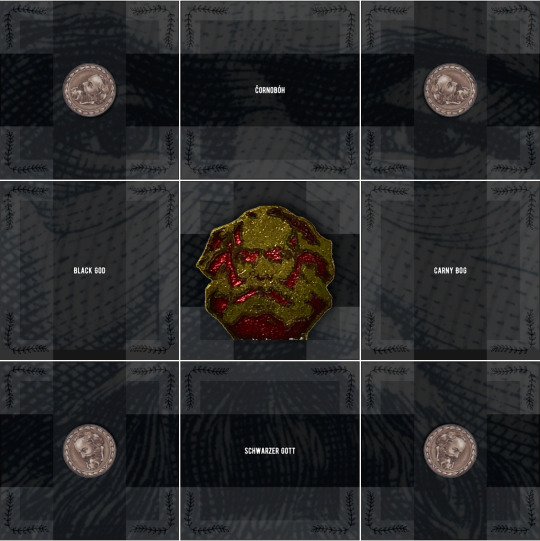
'Black God’ Digital Collage, 375 x 375 mm, 2023 Fine Art Pigment Print under Acrylic Glass, Black Aluminium Art Box
This is the second picture in the new 'Timeline Pictures' series: 'Black God'. The subject of the Black God has been part of my work since 2021. In autumn 2021, there was an attempt in Bautzen to rebuild a Bismarck monument on the highest mountain in Upper Lusatia, the Czorneboh. The Czorneboh is named after the black god of the Slavs (Upper Sorbian: Čorno Bóh).
The actual meaning in Sorbian mythology is scientifically disputed and was given a new meaning in the 19th century in the form of a re-romanticization, as pagan cult sites may have existed on the mountain.
The appearance of a god (idolatry) is always difficult. But I found it very charming to establish Lew Kerbel's Karl Marx Monument in Chemnitz as a counterpart to the new-right Bismarck cult. Especially since the Chemnitz monument itself can be considered a very impressive atheist idolatry. The Black God images that I created in 2021 are more likely to be understood as quotes and humorous comments.
Integrating Karl Marx as a figure into the Neue Sorbische Kunst canon is long overdue because, as a misunderstood superfigure of the international left, he fits perfectly into the ranks of tragic heroes such as Ernst Thälman, Herman Potočnik, Maria Grollmuss, Alfons Bauer, etc.
The present image in the layout of the timeline images is an attempt to integrate the Black God into the canon of early Neue Sorbische Kunst. Socialist agitation and propaganda liked to appear avant-garde - but in the GDR it is more petty bourgeois and small-minded party folklore with the absent context of modernity. In the spirit of over-identification inherent in NSK, I use these set pieces that can be recombined as desired.
#sb2130#Black God#Corno Boh#Czorneboh#Schwarzer Gott#Karl Marx#Neue Sorbische Kunst#NSK#NSK State Lipsk#Chemnitz#Karl-Marx-Stadt#Lew Kerbel#Monument#Philosopher#Capitalism#Slavic#Upper Lusatia#sorbian
0 notes
Text
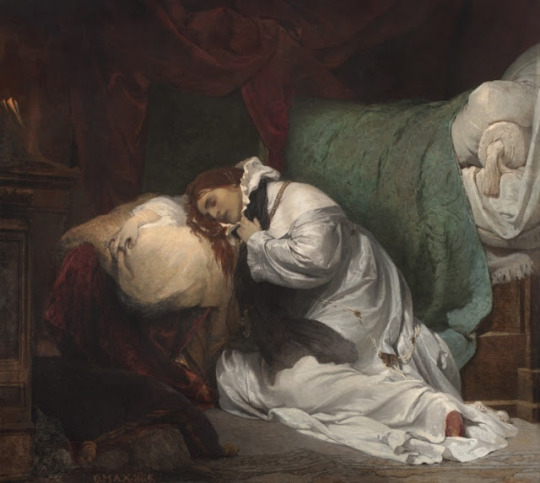
Saint Ludmila (c. 860 – 15 September 921) is a Czech saint and martyr venerated by the Orthodox and the Roman Catholics. She was the daughter of the Sorbian prince Slavibor. Saint Ludmila was the grandmother of Saint Wenceslaus, who is widely referred to as Good King Wenceslaus…
Please follow link for full post
Art,Paintings,Josef Mathauser,Gabriel von Max,RELIGIOUS ART,fine art,Religion,biography,History,Saint Ludmila,Zaidan,Ancient,Mythology,footnotes,Karel Škréta,
06 works, Today, September 18th, is Saint Ludmila's day, her story illustrated #260
#Icon#Bible#biography#History#Jesus#mythology#Paintings#religionart#Saints#Zaidan#footnote#fineart#Calvary#Christ
0 notes
Photo
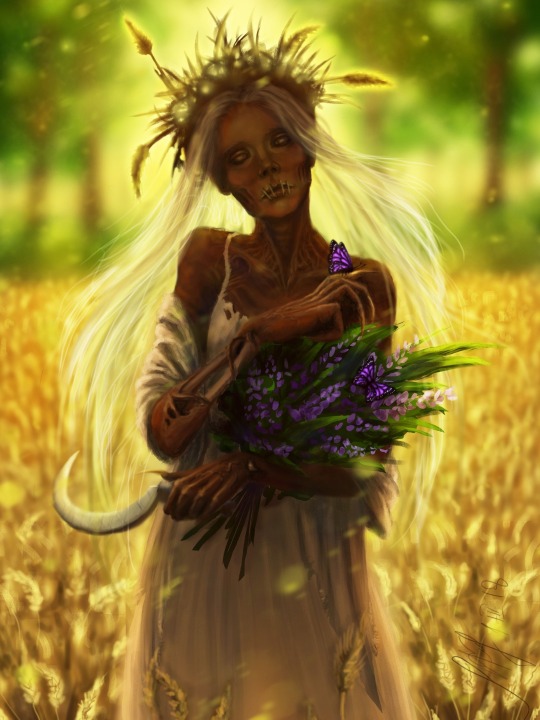

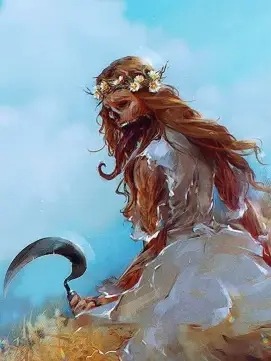
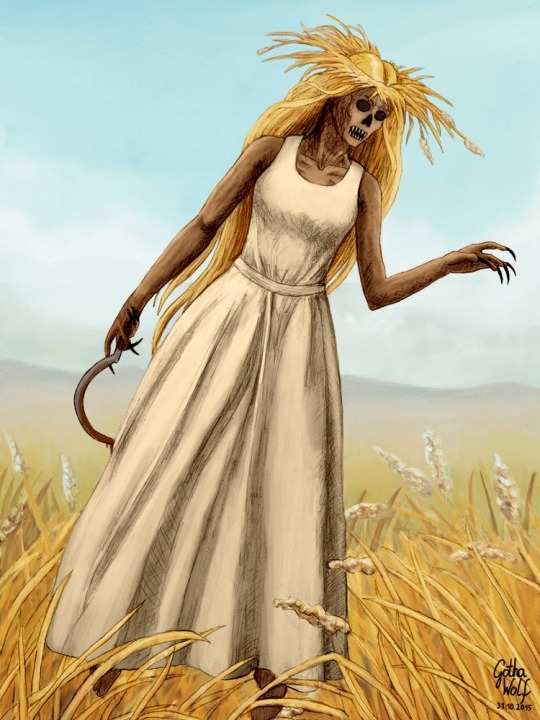
POLUDNITSA (LADY MIDDAY)
🌾 Poludnitsa (from: Polden or Poluden, 'half-day' or 'midday') is a mythical character common to the various Slavic countries of Eastern Europe. She is referred to as Południca in Polish, Полудница (Poludnitsa) in Serbian, Bulgarian and Russian, Polednice in Czech, Poludnica in Slovak, Připołdnica in Upper Sorbian, and Полознича (Poloznicha) in Komi, Chirtel Ma in Yiddish.
🌾 She is a noon demon in Slavic mythology. She can be referred to in English as "Lady Midday", "Noonwraith" or "Noon Witch". She was usually pictured as a young woman dressed in white that roamed field bounds. She assailed folk working at noon causing heatstrokes and aches in the neck, sometimes she even caused madness.
🌾 In some accounts, she symbolizes the midday star, thereby being the sister of Zarya-Zarenitsa (the morning star; also called Utrenica), Vechorka (the evening star; also called Wieczornica/Vechernitsa) and Kupalnitsa (the night star; also called Nocnica/Nochnitsa); Poludnitsa is the second youngest among the sisters, with Zarya-Zarenitsa being the youngest and Kupalnitsa being the oldest.
🌾 Poludnitsa, who makes herself evident in the middle of hot summer days, takes the form of whirling dust clouds and carries a scythe, sickle or shears; most likely the shears would be of an older style, not akin to modern scissors. She will stop people in the field to ask them difficult questions or engage them in conversation. If anyone fails to answer a question or tries to change the subject, she will cut off their head or strike them with illness. She may appear as an old hag, a beautiful woman, or a 12-year-old girl, and she was useful in scaring children away from valuable crops. She is only seen on the hottest part of the day and is a personification of a sun-stroke.
🌾 Poludnitsa, according to beliefs, loves to dance. If she sees a girl lying down to rest in the field, she will wake her up and begin to persuade her to dance. If the girl agrees, she will be forced to dance until the “evening dawn“. Poludnitsa cannot be beaten in dancing; however, if such a girl is found, the noon spirit will present her with a rich dowry.
#Poludnitsa#Lady Midday#slavic culture#slavic#slavs#slavic folklore#pagan#poland#russia#serbia#bulgaria#czechia#czech republic#slovakia#slavic mythology#posted by me#🔮
659 notes
·
View notes
Text
The Oldest Game
If you enjoyed The Oldest Game in The Sandman, you might like this version of a similar battle. It’s a song by the German band ASP, from a concept album about the legend of Krabat, depicting a duel between a dark wizard and one of his enslaved students. The lyrics are translated in the video.
youtube
And if you are into dark mythology (you like Sandman, of course you are!) you should probably check out Krabat. It's a sorbian legend about a young man who makes a deal with a dark magician, becoming one of his 12 pupils. Unfortunately the magician has a deal with the devil and has to sacrifice one of the boys every year. It's a beautiful and dark tale, the most famous version is the one by Otfried Preußler, but there is also a beautiful old Czech cutout animation movie.
#the sandman#the sandman netflix#sandman#the oldest game#a hope in hell#neil gaiman#mythology#krabat#asp#zaubererbruder#the sandman series#dream of the endless#Youtube
19 notes
·
View notes
Text
So I wanted to read up on slavic mythology a bit

[The Sorbian přepołdnica has the form of a large old woman in white clothes and with a sickle, or a small woman. At noon she walks out of the forest and appears to reapers in the fields, who she forces to talk about the same one thing for an hour...] (after that it says that those who do not succeed will have their head cut off or get cursed with a disease)

193 notes
·
View notes
Text

'Es gibt nur einen Čornobóh (There is only one black god)'
The impressive Karl Marx Monument illustrates very well Karl Marx as a counterpart to any politically right-wing or reactionary role model. The black appearance of the monument in the photo is the analogy to the black god in autochthonous Sorbian mythology. There is only one God who can stand up against the tendency to erase Sorbian history in the original settlement area. In my opinion, the bust of Karl Marx by Lev Kerbel is the optimal representation of a black god.
Čornobóh / Schwarzer Gott / Black God
Black God series, 2021
#czorneboh#bismarck#bautzen#karl marx#Das Kapital#Chemnitz#karl marx stadt#nsk#nskstate#nsk folk art#nsklipsk#black GOD#Neue Sorbische Kunst#Schwarzer Gott#Black God#Cornoboh#Lev Kerbel
2 notes
·
View notes
Note
I know of a few more examples from myths and legends. According to Edward Topsell, dragons love cabbage. The plón from Sorbian mythology loves cookies and porrige. And a dragon from Meerenschwanden in Switzerland stole vegetables from the fields.
Are any dragons herbivorous?
In mythology, YES! In Dracones Mundi, no.
Herbivorous Dragons
Horned serpents from Native American mythology eat sumac - I cannot find which culture said that they eat sumac, so I apologise for this gap in my knowledge
Mokele Mbembe, a ‘dinosaur cryptid’ from the Congo, is usually depicted as a man-eater, but Willy Ley said that in investigations conducted by Captain Ludwig Freiherr von Stein zu Lausnitz that the local people said the monster would eat liana vines.
There are probably more herbivore dragons but I’m just skim-reading my notes at the moment. There are also many dragons whose diet is not mentioned, and some dragons, rather than killing and eating livestock, would make animals sickly instead.
Some Herbivorous Pseudosuchians
The dragons in Dracones Mundi are based on pseudosuchians, or ‘crocodile-line archosaurs’, so here are some herbivorous animals I could have taken inspiration from:
Simosuchus - https://en.wikipedia.org/wiki/Simosuchus
Aetosaurs (there are many of these) https://en.wikipedia.org/wiki/Aetosaur (honestly an Aetosaur-tarasque would have been pretty cool in Dracones Mundi)
Shuvosaurus https://en.wikipedia.org/wiki/Shuvosaurus (which got mistaken for a dinosaur because… well look at it!)
Lotosaurus https://en.wikipedia.org/wiki/Lotosaurus
Where are the herbivorous dragons in Dracones Mundi?
I chose pseudosuchians as a base for dragons because they have evolved into many weird shapes in the past, and so were a nice clay to mold some dragon shapes out of. There are herbivorous pseudosuchians, there are herbivorous dragons, why have I not united the two?
Simply a matter of personal choice! I want Dracones Mundi to be fun to read, and therefore I try to have fun writing it. I go with my gut. “all the other dragons are predators, should I make this one dragon a herbivore, and try explaining why this one adapted differently?” I will think to myself. “Will this explanation take a long time, and not read smoothly? Should I cut it out and replace it with something else?”
In some versions I did have herbivore dragons, but in the current one I do not. This is simply a matter of taste, and of reading back through the text to see if the word flow works.
All my dragons are pretty closely related, a burden of going down the monophyletic route, and this means that whenever I made a dragon really different from the others (different teeth and different digestive anatomy in the case of herbivores - plant matter takes longer to break down and requires gut sections for it to sit in for a while, as well as different enzymes compared to animal matter) I have to make a proper explanation and a new branch of the family tree, and sometimes I just don’t think it fits too snugly.
If you’re writing your own dragon speculative evolution, totally throw in some herbivorous dragons, flex some creative muscles and find out new and wonderful facts on herbivorous animals - truly the internal anatomy needed to break down plant matter is some serious hardware, and its well worth brushing up on biology and learning some cool stuff.
Dragons like drinking milk in mythology, why not have a mammalian herbivore dragon, using the methane biproduct from digestion as a way to breathe fire?
These sort of cool thoughts are nice, just not something I am personally choosing to put in the Dracones Mundi book!
31 notes
·
View notes
Text
Belong
read it on the AO3 at https://ift.tt/2GcDkZo
by Ruis
“I know who I belong to“, Krabat said. He saw his mentor acknowledge the many-layered truth of that with a nod and a grim smile. “And still.”
Words: 100, Chapters: 1/1, Language: English
Fandoms: Sorbian Mythology & Folklore, Fairy Tales & Related Fandoms
Rating: Teen And Up Audiences
Warnings: No Archive Warnings Apply
Categories: Gen
Characters: Krabat (Sorbian Folklore), The Miller of Schwarzkollm (Sorbian Folklore)
Relationships: Krabat & The Miller of Schwarzkollm
Additional Tags: Fairy Tale Retellings, Folklore, Folk Tale, Deal with a Devil, Gothic, Dark Magic, Wizards, Drabble
read it on the AO3 at https://ift.tt/2GcDkZo
0 notes
Text
Too Important to be Honest
read it on the AO3 at http://bit.ly/2NabpiA
by Ruis
Krabat, trickster-mage extraordinaire, can't be honest to save his soul - literally. At some point, he has no choice but to explain a few things to his mom. Mom is not happy.
Words: 100, Chapters: 1/1, Language: English
Fandoms: Sorbian Mythology & Folklore, Fairy Tales & Related Fandoms
Rating: General Audiences
Warnings: No Archive Warnings Apply
Categories: Gen
Characters: Krabat (Sorbian Folklore), Krabat's mother (Sorbian Folklore)
Relationships: Krabat & Krabat's mother
Additional Tags: Krabat myth, Folk Tale, Dark Magic, Drabble, Fairy Tale Retellings, Mythology - Freeform
read it on the AO3 at http://bit.ly/2NabpiA
0 notes
Text
Your Left
read it on the AO3 at http://bit.ly/2KEQ9PN
by Ruis
It's well known what became of Schwarzkollm's water mill in the end. This tells the story of its beginning.
Words: 100, Chapters: 1/1, Language: English
Fandoms: Sorbian Mythology & Folklore, Fairy Tales & Related Fandoms
Rating: Teen And Up Audiences
Warnings: No Archive Warnings Apply
Categories: Gen
Characters: The Miller of Schwarzkollm (Sorbian Folklore), The Devil
Relationships: The Miller of Schwarzkollm & The Devil
Additional Tags: watermill, Folk Tale, Krabat myth, Drabble, Dark Magic, Deal with a Devil, Devil Pact, Fairy Tale Retellings, Mythology - Freeform
read it on the AO3 at http://bit.ly/2KEQ9PN
0 notes